
Central Europe is the region comprising the central part of Europe. It is said to occupy continuous territory that are otherwise conventionally Western Europe, Southern Europe, and Eastern Europe. The concept of Central Europe is based on a common historical, social and cultural identity. Central Europe is going through a phase of "strategic awakening", with initiatives such as the CEI, Centrope and the Visegrád Four. While the region's economy shows high disparities with regard to income, all Central European countries are listed by the Human Development Index as very highly developed.
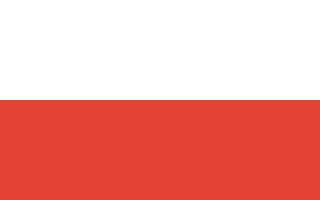
The Second Polish Republic, commonly known as interwar Poland, refers to the country of Poland in the period between the First and Second World Wars (1918–1939). Officially known as the Republic of Poland, sometimes Commonwealth of Poland, the Polish state was re-established in 1918, in the aftermath of World War I. When, after several regional conflicts, the borders of the state were fixed in 1922, Poland's neighbours were Czechoslovakia, Germany, the Free City of Danzig, Lithuania, Latvia, Romania and the Soviet Union. It had access to the Baltic Sea via a short strip of coastline either side of the city of Gdynia. Between March and August 1939, Poland also shared a border with the then-Hungarian governorate of Subcarpathia. The Second Republic ceased to exist in 1939, when Poland was invaded by Nazi Germany, the Soviet Union and the Slovak Republic, marking the beginning of the European theatre of World War II.
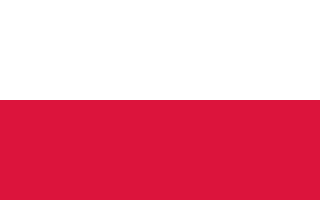
Poland, officially the Republic of Poland, is a country located in Central Europe. It is divided into 16 administrative subdivisions, covering an area of 312,696 square kilometres (120,733 sq mi), and has a largely temperate seasonal climate. With a population of approximately 38.5 million people, Poland is the sixth most populous member state of the European Union. Poland's capital and largest metropolis is Warsaw. Other major cities include Kraków, Łódź, Wrocław, Poznań, Gdańsk, and Szczecin.

The economy of Poland is the eighth largest economy in the European Union and the largest among the former Eastern Bloc members of the European Union. Since 1990 Poland has pursued a policy of economic liberalization and its economy was the only one in the EU to avoid a recession through the 2007-2008 economic downturn. In all, as of 2017 the Polish economy has been growing steadily for the past 26 years, a record high in the EU. Such growth has been exponential, with GDP per capita at purchasing power parity growing on average by 6% p.a. over the last 20 years, the most impressive performance in Central Europe resulting in the country doubling its GDP since 1990.
Civic Platform is a liberal-conservative and Christian democratic political party in Poland. Civic Platform came to power following the 2007 general election as the major coalition partner in Poland's government, with party leader Donald Tusk as Prime Minister of Poland. Tusk was re-elected as Prime Minister in the 2011 general election but stepped down three years later to assume the post of President of the European Council. Prime Minister Ewa Kopacz led the party in the 2015 general election but was defeated by the Law and Justice party. On 16 November 2015 Civic Platform government stepped down after exactly 8 years in power. In 2010 Civic Platform candidate Bronisław Komorowski was elected as President of Poland, but failed in running for re-election in 2015. PO is the second largest party in the Sejm, with 138 seats, and the Senate, with 33 seats. Civic Platform is a member of the European People's Party (EPP).
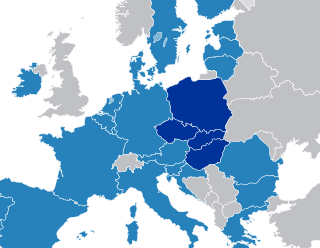
The Visegrád Group, Visegrád Four, or V4 is a cultural and political alliance of four Central European states – the Czech Republic, Hungary, Poland and Slovakia, that are members of the European Union (EU) and NATO – for the purposes of advancing military, cultural, economic and energy cooperation with one another along with furthering their integration in the EU.

A województwo is the highest-level administrative subdivision of Poland, corresponding to a "province" in many other countries. The term "województwo" has been in use since the 14th century, and is commonly translated in English as "province". Województwo is also rendered in English by "voivodeship" or a variant spelling.

The Partitions of Poland were three partitions of the Polish–Lithuanian Commonwealth that took place toward the end of the 18th century and ended the existence of the state, resulting in the elimination of sovereign Poland and Lithuania for 123 years. The partitions were conducted by Habsburg Austria, the Kingdom of Prussia, and the Russian Empire, which divided up the Commonwealth lands among themselves progressively in the process of territorial seizures and annexations.

The Poles, commonly referred to as the Polish people, are a nation and West Slavic ethnic group native to Poland in Central Europe who share a common ancestry, culture, history, and are native speakers of the Polish language. The population of self-declared Poles in Poland is estimated at 37,394,000 out of an overall population of 38,538,000, of whom 36,522,000 declared Polish alone.

The Polish–Lithuanian Commonwealth – formally, the Crown of the Kingdom of Poland and the Grand Duchy of Lithuania and, after 1791, the Commonwealth of Poland – was a dual state, a bi-confederation of Poland and Lithuania ruled by a common monarch, who was both King of Poland and Grand Duke of Lithuania. It was one of the largest and most populous countries of 16th– to 17th-century Europe. At its largest territorial extent, in the early 17th century, the Commonwealth covered almost 400,000 square miles (1,000,000 km2) and sustained a multi-ethnic population of 11 million.

The Polish–Soviet War was fought by the Second Polish Republic, Ukrainian People's Republic and the proto-Soviet Union over a region comparable to today's westernmost Ukraine and parts of modern Belarus.
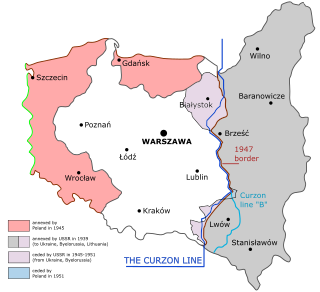
The territorial changes of Poland immediately after World War II were very extensive, the Oder–Neisse line became Poland's western border and the Curzon Line its eastern border. In 1945, after the defeat of Nazi Germany, Poland's borders were redrawn in accordance with the decisions made first by the Allies at the Tehran Conference of 1943 where the Soviet Union demanded the recognition of the military outcome of the top secret Nazi–Soviet Pact of 1939 of which the West was unaware.
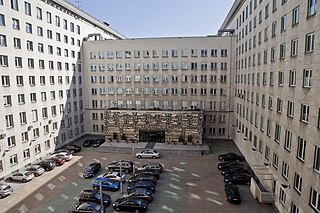
Narodowy Bank Polski is the central bank of Poland. It controls the issuing of Poland's currency, the złoty. The Bank is headquartered in Warsaw, and has branches in 16 major Polish towns. The NBP represents Poland in the European System of Central Banks, an EU organization.

The administrative division of Poland since 1999 has been based on three levels of subdivision. The territory of Poland is divided into voivodeships (provinces); these are further divided into powiats, and these in turn are divided into gminas. Major cities normally have the status of both gmina and powiat. Poland currently has 16 voivodeships, 380 powiats, and 2,478 gminas.

Viacom International Media Networks (VIMN) is the international division of Viacom. The company oversees the production, broadcasting and promotion of key Viacom brands outside of the United States. These brands include MTV, VH1, Nickelodeon, Comedy Central, BET, VIVA, Colors and Game One.
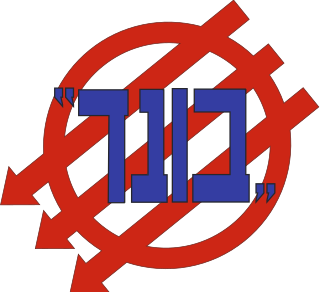
The General Jewish Labour Bund in Poland was a Jewish socialist party in Poland which promoted the political, cultural and social autonomy of Jewish workers, sought to combat antisemitism and was generally opposed to Zionism.

Comedy Central Family is a Polish channel focusing on comedy from Viacom International Media Networks Polska. It was launched on April 29, 2010 as a program block on VH1 Poland. On January 14, 2011 VH1 Poland was replaced with Comedy Central Family.
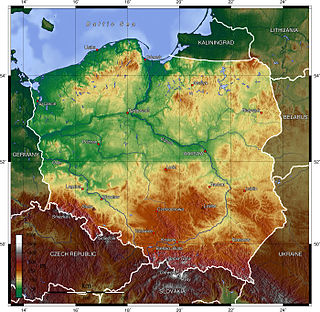
Poland is a country in East-Central Europe with an area of 312,679 square kilometres, and mostly temperate climate. Generally speaking, Poland is an almost unbroken plain reaching from the Baltic Sea in the north, to the Carpathian Mountains in the south. Within that plain, terrain variations run in bands east to west. The Baltic coast has two natural harbors, the larger one in the Gdańsk-Gdynia region, and a smaller one near Szczecin in the far northwest. The northeastern region, also known as the Masurian Lake District with more than 2,000 lakes, is densely wooded and sparsely populated. To the south of the lake district, and across central Poland a vast region of plains extends all the way to the Sudetes on the Czech and Slovak borders southwest, and to the Carpathians on the Czech, Slovak and Ukrainian borders southeast. The central lowlands had been formed by glacial erosion in the Pleistocene ice age. The neighboring countries are Germany to the west, the Czech Republic and Slovakia to the south, Ukraine and Belarus to the east, and Lithuania and the Russian exclave of Kaliningrad to the northeast.


















